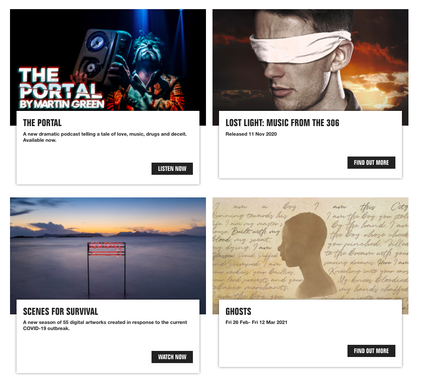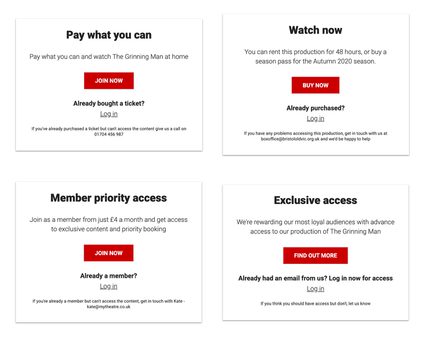Supercool's Spektrix-integrated paywall
This post is based on a webinar delivered to Supercool clients and Spektrix team members last week.
Introducing our new Spektrix-integrated paywall feature – helping clients to monetise digital content and collect audience data, while keeping it simple for their audiences.
It’s been a strange year. And for us, a busy one. More than ever cultural organisations are relying on their websites to engage with audiences, and deliver their mission. With buildings closed, tours cancelled, and meet-ups not possible, we’ve been inundated with requests to update websites so they can better cope with the new normal.
Whilst there have been lots of creative and different approaches to how organisations have tackled these challenges, there have been some recurring themes:
Digital events
What’s On sections have traditionally been used to list upcoming events; which have traditionally had defined start and end times. But with events now being delivered in new ways, this isn’t always the case anymore.
We’ve spent a lot of time updating the logic on What’s On pages so they can handle digital events and activities. This means thinking differently about dates, button text, and when these activities drop off the listings. An example of this is National Theatre of Scotland who offer regular events and podcasts online.

A global reach
Breaking free from the confines of a venue has meant organisations can reach a more geographically widespread audience. A great example of this was The WOW Foundation’s global 24-hour online festival, which took place in June. Not only did the festival reach a worldwide audience, but the team coordinated content from all across the globe over the full 24 hours.
This global reach is true of all digital events. We’re yet to see the full impact of this, but with such hugely expanded audiences comes increased opportunity.
It’ll be interesting to see how organisations develop relationships with audiences and supporters across the globe over the coming months and years.

Audiences still want shared experiences
Despite the lack of in-person events, audiences don't seem to have reduced. If anything, by offering content online, they have grown.
Both City of Birmingham Symphony Orchestra (CBSO) and Scottish Chamber Orchestra (SCO) released concerts at a specific date and time. Despite clearly stating these concerts will be available after the release, thousands of people tuned-in for the premieres.
This suggests that, although we can’t be together in a room, audiences are craving those shared experiences. We can see – through comments and social interaction with events – that people still want to feel connected. This leads to huge numbers tuning-in to live events.
On the evening CBSO streamed their 100th anniversary concert, over 77,000 people watched live – considerably more than would fit into any classical music venue!
Common challenges
Through our conversations with organisations, we’ve started to see similarities in approaches and some common challenges.
Monetising content
Budgets are tight, and putting on an event is costly. Having spent time experimenting, many organisations now want to monetise their digital content. But this can work in lots of different ways – from donations, to subscription services, and one-off purchases.
Keeping it simple
Your customers are used to your website! And things need to be kept as simple and familiar as possible for your audiences; now more than ever. Creating complex purchase paths, requiring multiple logins, and using different platforms can be confusing for users.
Losing-out on customer data
With no physical performances and no ticket sales, organisations are losing out on data. This is especially painful for organisations who have sophisticated audience development strategies. By using third-party platforms or offering content for free, you no longer know who your loyal (or new) audiences are.
Lack of process (so far)
This is possibly the biggest challenge right now. Everyone has similar goals, but there are lots of variations in how these are achieved; there’s no standard way to charge for content at the moment. We’ve seen organisations ask for donations, 'pay what you can', sell individual productions, and full seasons.
Using our experience, observations of organisational pivots, and considering those challenges we’ve identified, we developed a nifty solution …

Introducing our new paywall feature!
Our Spektrix-integrated paywall feature sits within a client's website; and can be added to any page.
? Neat integration
Data on a user’s Spektrix account grants access to content, based on tags. Auto-tags can attach to customers as they meet criteria, and/or tags can be manually-added to specific customers.
? Monetise anything
All types of content can be offered behind the paywall. This includes embedded videos, so you can use it as a paid-for video player, but also text, images, downloads, forms, galleries … any of the usual content that can be added to a website.
? Adaptable to your message
Clients have complete control over the content of the paywall itself; every single bit of text!
… all of which makes it incredibly flexible.

Monetising content

There are lots of choices when it comes to selling content. You could use donations, like Traverse Theatre have done for their festival.
You could ask users to 'pay what you can' using ticket types at different prices. Or sell access to productions via merchandise, memberships, or regular tickets.
Perhaps you could give users access based on their booking history, mailing list sign-up, past giving history – or even an email domain (e.g. everyone within an organisation could have access, based on their work email address).
Other ideas
Whilst our focus has been on providing a tool for our clients to quickly monetise digital content, we also thought about how the flexibility would be useful for other things.
Because you can put any content behind the paywall – and you can use any criteria in Spektrix to tag customers – there are lots of uses for this tool:
- Create a members only area where members log in to access exclusive content (not usually advised, but may be a consideration)
- Hide sensitive information like technical specifications or rehearsal schedules behind a login
- Create a Resource Hub for people who are attending a course or class
- Have a basic staff area behind a login
What next?
Our plan is to see the paywall in action, gather feedback, and make improvements. The aim: develop a tool that's highly flexible, and relevant to lots of organisations – helping to share-out the cost and keep it affordable.
To find out more, get in touch to arrange a chat: kate@supercooldesign.co.uk